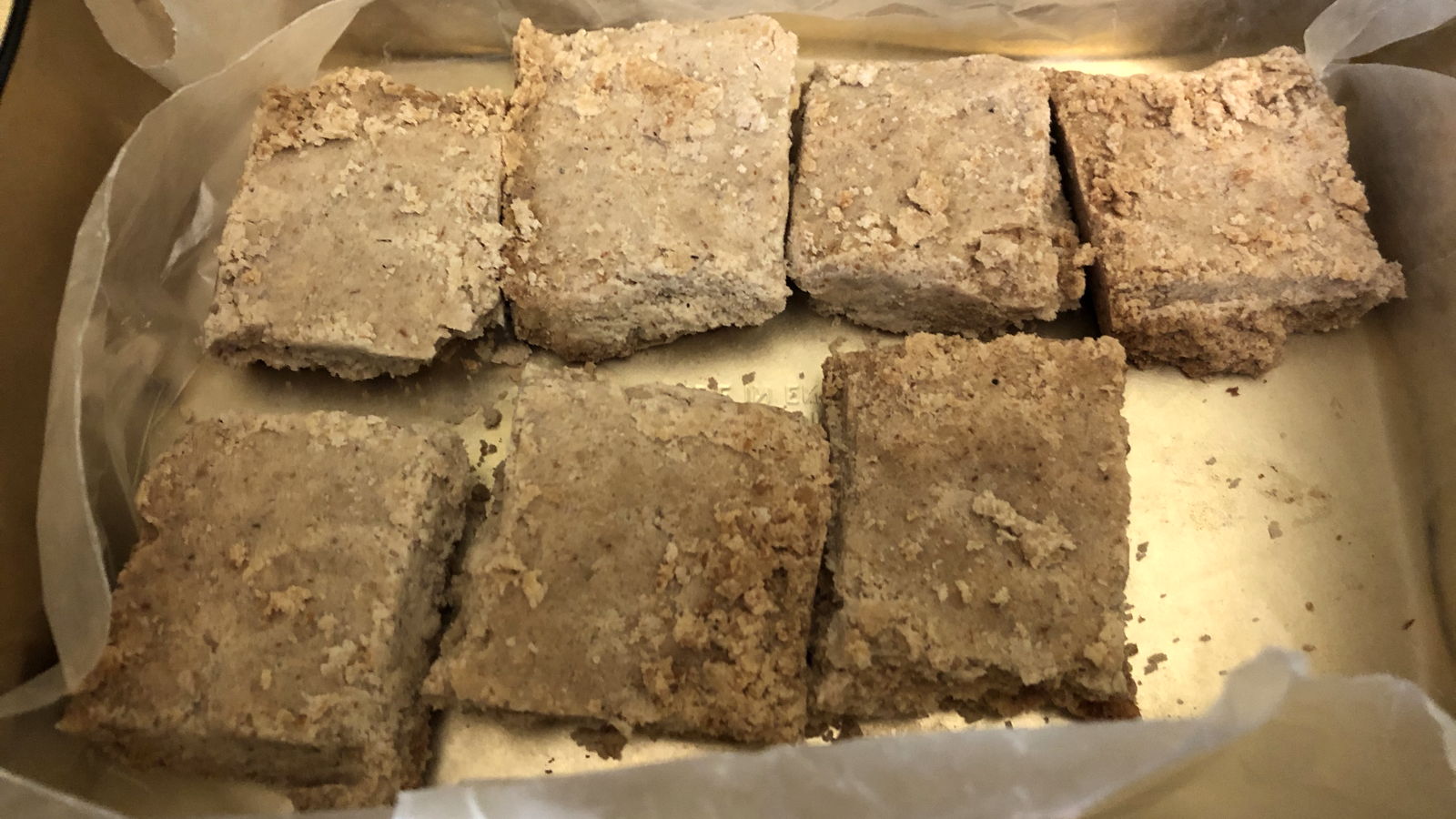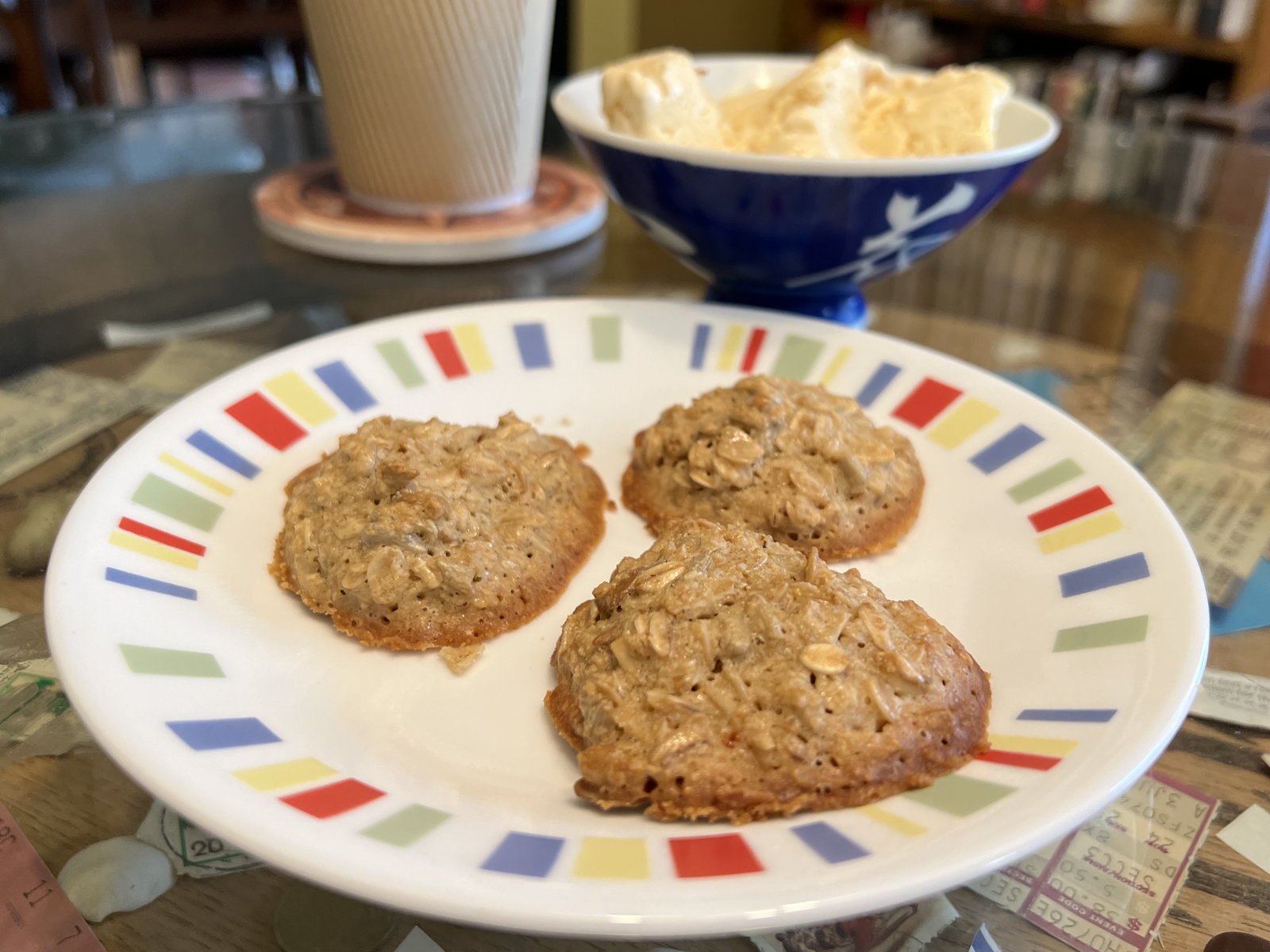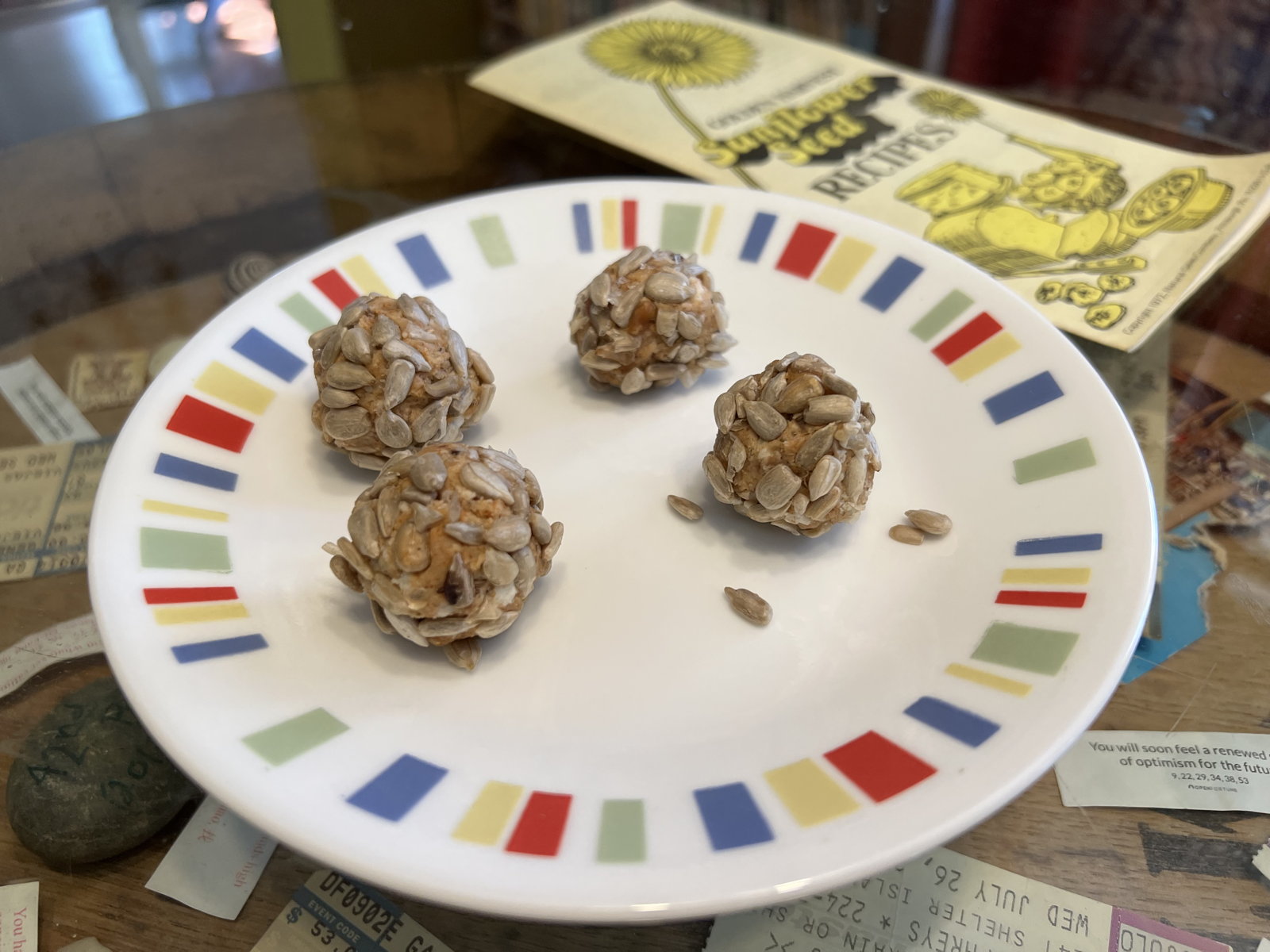A golden harvest of sunflower seeds
Golden Harvest Sunflower Seed Recipes (PDF File, 2.6 MB): A fascinating bit of ephemera from the early seventies.
Back in the last century, along with the regional specialty food manufacturers that famously included extract companies like Adams Extract the United States also hosted several specialty regional nut and grain mills. One of my first glimpses of this is in a wonderful old cookbook from El Molino Mills of Alhambra, California. And Beatrice Trum Hunter references many such companies in her Whole-Grain Baking Sampler•.
Unlike the extract companies, these natural grain mills were a natural ally with the counterculture granola movement of the sixties and seventies. Unfortunately, while all of the mills I’m aware of long-predated the sixties counterculture, few survived it.
This Golden Harvest Sunflower Seed Recipes (PDF File, 2.6 MB) pamphlet came in at the tail of that movement, 1972. Golden Harvest was a brand or subsidiary of General Nutrition Corporation. The company seems to still exist, but they appear to be mostly a vitamin sales company. They abandoned both of this pamphlet’s trademarks at about the same time. Golden Harvest expired on December 14, 1985 and Natural Sales Company on January 12, 1986.
The whole grain mindset of these companies was usually somewhat different than the natural foods mindset of their sixties and especially seventies customers. Most modern “natural” recipes that replace white sugar in traditional recipes with honey and whole grains also eschew sugar and fat, resulting in less flavorful meals. That’s not true with books like Hunter’s, and especially not with this pamphlet.
I made the Oatmeal-Sunflower Seed Cookies and in place of the approximately one cup of sugar that more traditional cookie recipes would call for, this recipe calls for a cup of honey. In place of the ¾ cup of butter, it calls for a full cup of sunflower seed oil.
Of course, one of the things Natural Sales Company sold was sunflower seed oil, so that was a serendipitous coincidence for them!
I also didn’t realize when I started making these cookies that the recipe doesn’t call for any wheat flour. The only grains in the cookies are oat flour and oat meal.
That plus the relatively large amount of honey and oil makes for a very rich cookie. I don’t normally prefer soft, mounded cookies. I like the crunchy and chewy ones, like the oatmeal-coconut cookies from The Baker’s Dozen. But I ate these soft, mounded cookies like… well, like candy.
Healthy? Probably not. But almost certainly healthier and there’s no flavor lost in this gluten-free recipe from before gluten-free transitioned from a medical condition to a celebrity fad.
Note that, rather than keeping oat flour on hand I make my oat flour by grinding the same volume of oatmeal. That is, for each cup of oat flour, I grind a cup of oatmeal in a spice/coffee grinder. As far as I can tell, that’s literally what oat flour is.

Yummy. Ginger and sunflower seeds is a surprisingly good combo. The addition of garlic helped a lot, too.
The recipes in this pamphlet all call for sunflower seed products—GOLDEN HARVEST sunflower seeds, of course. Unlike the El Molino Mills cookbook, there is no mention of them being “hulled” sunflower seeds. That’s either because Golden Harvest didn’t make unhulled sunflower seeds, or, by this time, pre-hulled sunflower seeds were common enough as a snack food that Golden Harvest didn’t need to clarify that the seeds needed to be hulled first. I suspect a combination of the two.
Judging from these recipes, I’m also nearly certain that Golden Harvest sunflower seeds were roasted and salted. I’m not sure it’s always necessary; the cookies, for example, would probably also be very good with the unique flavor of unroasted sunflower seeds. But the Sunflower Seed Casserole almost certainly wouldn’t. It needs both the roasted flavor to bring the casserole flavor up, and the salt—it gets all of its salt from the sunflower seeds.
As a counter-argument, the Sunflower Seed Quick Bread specifically calls for “toasted Sunflower Seeds”. But while I could see using raw sunflower seeds in the cookies (they’ll get baked, after all) I just can’t see using raw sunflower seeds in the casserole. They’re mixed in at the end, never cooked at all. They need the flavor of roasting and salting to make them crunch in the mix. I suspect the wording in the quick bread recipe is an artifact of where Natural Sales Company got the recipe from.
My general rule of thumb is that salted nuts contain about a quarter teaspoon of salt per cup of nuts or seeds, and I add about that much salt to any recipe that calls for them if I’m roasting my own. Sometimes I’ll add more if I think the recipe calls for it. For example, I added ¼ teaspoon salt to the Oatmeal-Sunflower Seed Cookies even though it only calls for ½ cup sunflower seeds, and that seemed to do the trick perfectly.
This is a very good casserole—and reminiscent of the best made by my more natural foods-minded friends in the eighties. The only powdered spice it calls for is ginger, and even that’s given the option of fresh ginger root (although it does not say to triple the amount if you use fresh, which I did). I also added a couple of cloves of fresh garlic, because I’d used them to rub the sides of a casserole dish for a different recipe.
This is not technically a casserole. It isn’t baked in the oven or even in a casserole dish. It can be served in a casserole dish, however, which is what I did. The vegetables are cooked in a pan on the stove, then the sunflower seeds mixed in, and the whole served “on a bed of cooked brown rice”. I put the brown rice in a small decorative casserole dish and poured the vegetables over the top, as you can see in the photo.
The recipe says it makes four servings, but it does not specify the amount of brown rice. I used ½ cup dry jasmine brown rice simmered in a cup of water. Obviously, the recipe could be stretched further by using more rice, but at ½ cup it’s already what I’d call six to eight servings.
It’s a very good dish, and it does look like a casserole when it’s served the way I did. It’s very much a comfort food, and among the healthiest comfort foods in my rotation!
The only disappointing recipe I made were the Sunflower Seed Balls, which is an odd combination of cottage cheese, wheat germ, and spices, rolled in sunflower seeds. The celery seed, dill, caraway, and paprika sounded like it ought to be a good flavor combination, but it didn’t seem to combine well with the cottage cheese.
It was definitely an interesting recipe. And interesting recipes are not lacking in this very small pamphlet. I’m still looking forward to the biscuits, as well as the banana cake—a yeasted cake—and the walnut cake, which appears to use walnuts and sunflowers for texture instead of flour.
Golden Harvest Sunflower Seed Recipes (PDF File, 2.6 MB)
As a bonus, here’s another interesting recipe using sunflower seeds. This is my version of Edward Espe Brown’s Tahini Shortbread from Tassajara Cooking.

Sunflower Shortbread
Servings: 36
Preparation Time: 1 hour
The Tassajara Trilogy
Ingredients
- 1 cup raw sunflower seeds
- ¼ cup sunflower seed oil
- ½ cup sugar
- ½ tsp salt
- 1¾ cup flour
Steps
- Grind the sunflower seeds smooth with the oil.
- Mix in the sugar and salt.
- Add enough flour until the dough is firm, working with your hands at the end.
- Press into a nine-inch pie tin or 8x8 square pan.
- Mark into pieces; cut about halfway through.
- Bake at 325° for about 45 minutes, until the center is firm when gently pressed.
In response to Vintage Cookbooks and Recipes: I have a couple of vintage cookbooks queued up to go online.
- Golden Harvest Sunflower Seed Recipes (PDF File, 2.6 MB)
- A 1972 sunflower seed cookbook from Golden Harvest and Natural Sales Company, part of General Nutrition Corporation.
- Adams Extract
- “Adams traces its beginnings back to Battle Creek, Michigan, when John A. Adams began making and selling his Green Plant Sarsaparilla extract, Adamur, in 1888. In 1905, he moved his family to Beeville, TX.”
- Baker’s Dozen Coconut Oatmeal Cookies
- The Baker’s Dozen coconut oatmeal cookies, compared to a very similar recipe from the Fruitport, Michigan bicentennial cookbook.
- El Molino Best: Whole grains in 1953
- El Molino Mills of Alhambra, California, published a fascinating whole grain cookbook in 1953.
- The Tassajara Trilogy
- Review of The Tassajara Trilogy: Tassajara Cooking, Tassajara Recipe Book, and Tassajara Bread Book, with a recipe for Smoked Greens.
- Whole-Grain Baking Sampler• (paperback)
- This marvelous book contains recipes for a variety of breadstuffs: breads, rolls, biscuits, cookies, bars, and other sticky things. Most of them use whole grains (obviously) and are fairly easy to make.
More cookbooks
- Cookbook publication year estimates I have made
- When I acquire a cookbook without a publication or copyright year, I use the advertisements and contributors to make a stab at the likely year of publication. This page provides those guesses in case it helps you date your own books.
- Refrigerator Revolution Revisited: 1937 Kitchen-Proved
- Refrigerators started to take off during Prohibition, and became ubiquitous following World War II. This Westinghouse refrigerator manual and cookbook gives us a glimpse at home refrigerator/freezers in the Great Depression.
- Four New Ices and an Ice Cream Cookery
- Philadelphia Ice Cream, Walnut Nougat, Lemon Cream Sherbet, and Cranberry Ice. Four more new no-churn ice creams and desserts for Summer 2025. And, a book collecting all my favorite no-churn ice creams if you’re interested!
- My Year in Food: 2024
- From Italy, to San Diego, to Michigan, and many points in between; and from 1876 up to 2024 with stops in the 1920s, this has been a great food year.
- Mrs. Winslow’s Domestic Receipt Book for 1876
- If this is what people were eating in 1876, they were eating very well. From coconut pie to molasses gingerbread to tomato jam, these are great recipes—albeit requiring some serious interpretation.
- 72 more pages with the topic cookbooks, and other related pages
More food history
- Using search engines to guess cookbook years
- Many cookbooks, especially community cookbooks and often advertising pamphlets, leave off the year. Often, however, there are solid clues in the text that narrow down when the book was published, through simple online searches.
- Cookbook publication year estimates I have made
- When I acquire a cookbook without a publication or copyright year, I use the advertisements and contributors to make a stab at the likely year of publication. This page provides those guesses in case it helps you date your own books.
- Refrigerator Revolution Revisited: 1937 Kitchen-Proved
- Refrigerators started to take off during Prohibition, and became ubiquitous following World War II. This Westinghouse refrigerator manual and cookbook gives us a glimpse at home refrigerator/freezers in the Great Depression.
- A Vicennial Meal for the Sestercentennial
- In 1776 we were too busy to write commemorative cookbooks. But in 1796 “Amelia Simmons, American Orphan” published the first known American cookbook. It’s a celebration of American foods, American values, and American economies.
- Mom’s High School Cooking Notebook, 1960
- My mother kept her high school recipe notebook for as long as I can remember. It was often on the kitchen counter when the counter was dusted with flour.
- 23 more pages with the topic food history, and other related pages
More seventies
- Plain & Fancy in the seventies with Hiram Walker
- Enjoy a whole new world of fun, excitement and discovery in Hiram Walker Cordials, adding a personal touch to all your memorable moments and special occasions—plain or fancy!
- A Bicentennial Meal for the Sestercentennial
- Four community cookbooks celebrating the bicentennial. As we approach our sestercentennial in 2026, what makes a meal from 1976?
- Hesperia Class of ’82
- The 40th reunion for the Hesperia High School Class of 1982 is July 15 through July 17, 2022. We look forward to seeing you!
- Hobby Computer Handbook: From 1979 to 1981
- Hobby Computer Handbook lived for four issues, from 1979 to 1981. Back in 1979 and 1980, I bought the middle two issues. I’ve recently had the opportunity to buy and read the bookend issues.
- Better for being ridden: the eternal lie of the anointed
- Whenever there’s a crisis, politicians and the media always tell us that if we do what they say, we’ll be all right. This is always a lie. And however often they fail and however many die from their ministrations, their wabbling fingers always return to the mire.
- Six more pages with the topic seventies, and other related pages


